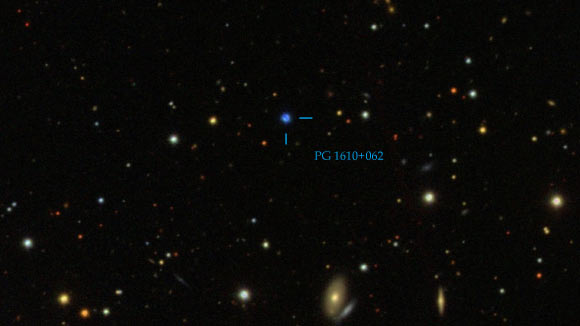One of Milky Way’s Most Extreme Runaway Stars Discovered | Astronomy – Sci-News.com
A runaway star called PG 1610+062 was probably ejected from the Milky Way’s Carina-Sagittarius spiral arm at a velocity of 1,230 mph (550 km/s) with the help of an intermediate-mass black hole, according to a paper published in the journal Astronomy & Astrophysics.
While formerly considered an old star with half a solar mass, typical for the galactic halo, new data from W.M. Keck Observatory’s Echellette Spectrograph and Imager revealed that PG1610+062 is actually a surprisingly young star that’s ten times more massive, ejected from the Galactic disk almost at the escape velocity from the Milky Way.
Some even faster stars, called hypervelocity stars (HVSs), do exist — the first three were discovered in 2005.
Among them is the unique star US 708, which was found in 2005 by astronomers from the University of Hawaii and the Friedrich-Alexander University of Erlangen-Nuremberg. US 708 was going so fast it escaped the Milky Way’s gravitational pull.
Simulations carried out in 1988 suggested that a supermassive black hole could do the trick. By disrupting a binary star system, i.e. swallowing one star and leaving its stellar partner with all the energy in the system, ejecting it far beyond the escape velocity of the Milky Way.
Lacking other plausible explanations for the formation of HVSs, this scenario was readily accepted as the standard ejection mechanism, in particular after observational evidence for the existence of such a supermassive black hole at the Galactic center — known as Sagittarius A* — became overwhelming in the early 2000s.
By using the unprecedented astrometric precision measurements from ESA’s Gaia spacecraft, PG1610+062 has been traced back to nowhere near the Galactic center, but to the Carina-Sagittarius spiral arm, therefore ruling out the idea that Sagittarius A* slingshot the star.
Even more interesting is the derived extreme acceleration of PG1610+062, which excludes most likely all alternative scenarios except the interaction with an intermediate-mass black hole.
“PG1610+062 may provide evidence that intermediate-mass black hole could indeed exist in our Galaxy,” said Dr. Andreas Irrgang, an astronomer at the Friedrich-Alexander University of Erlangen-Nuremberg.
“The race is on to actually find them.”
_____
A. Irrgang et al. 2019. PG 1610+062: a runaway B star challenging classical ejection mechanisms. A&A 628, L5; doi: 10.1051/0004-6361/201935429







